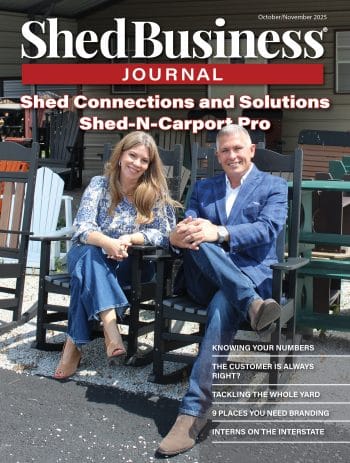Your website is often the first point of contact potential customers have with your shed business, and as we know, first impressions matter.
As soon as they land on your site, you want to show potential customers exactly what your brand is all about.
That’s why brand representation is such an important part of a successful website. From the layout and design to the type of language you use, all the components of your site should work together to tell the unique story of your brand.
On the best websites, you can sometimes get a sense of the brand’s values, mission, and unique selling points—just from the feel of the website itself. That’s the power of brand representation. It makes your business more memorable and builds trust with your audience.
This article will explain why brand representation is vital to your website’s success, how clients respond to a great website, and the difference between an average website and an exceptional one. Not sure if your website truly aligns with your brand image? We’re here to help you figure that out, too.
The Importance of Brand Representation on Your Website
A website that doesn’t match up with your brand identity can confuse your target audience and leave them with a negative impression of your business.
For example, let’s say you’ve promoted your shed building company elsewhere as prioritizing customer service and quality craftsmanship, but your website looks a little sloppy and your contact information is nowhere to be found. This can cast serious doubt on everything you’ve told potential customers about your business.
And if they doubt your credibility, they’ll lose trust, and there’s a real risk they’ll abandon your site and choose one of your competitors instead. This is the last thing you want. Thankfully, it can be avoided by making sure every page on your website paints a clear picture of your brand’s identity.
How to Represent Your Brand Clearly on Your Website
Let’s find out if your brand personality and website are really in alignment. Ask yourself the following questions—if you find yourself answering “no” to any of them, it might be time for some changes.
- Is your website consistent with other platforms? Your website branding—including visual branding like colors, logo, typography, and imagery—should be consistent across all your platforms and marketing materials.
- Does your website tell your story? A portion of your website should be dedicated to telling your business story (in language that matches your brand tone of voice). This usually takes the form of an About page.
- Are your brand values easy to identify? Visitors should be able to tell what’s important to your business and the values you represent just by exploring your site.
- Do you feel proud of your website? If your website feels like a true reflection of your business and you’re proud to show it off, it’s likely doing an excellent job of showing your audience who you are.
Just remember: just because a website looks amazing doesn’t mean it accurately represents your brand. The key is to create a branded design that does.
How Do Visitors Respond to a Good Website?
When people come to your shed business’s website, they’re looking for two things: sheds (of course) and credibility. They want to know you offer the product they need and service they can trust.
Clear, consistent branding is key to building that trust. When a website is well designed, easy to use, and clearly communicates your brand’s message, it reassures them that they can rely on your products and service—and encourages them to convert.
This goes beyond making a good impression—it’s about prioritizing a positive user experience to get real positive results. A study by McKinsey & Company found that websites with a high perceived user experience (UX) have a 200 percent higher conversion rate than those with a low perceived UX.
In other words, when your website is on-brand, straightforward, and easy to navigate, visitors are much more likely to take your desired action, whether that’s:
- Making a purchase.
- Signing up for your company newsletter.
- Filling out a contact form.
- Registering for an event.
- Downloading an eBook.
- Creating an account.
What Do Customers Expect to Find on Your Website?
Today’s customers have high expectations about what a website offers. The most common elements consumers want to see on your website include:
Product or Service Details:
- Customers want full descriptions and high-quality images of your offerings to help them make an informed decision about buying your sheds or hiring your shed-building services.
Easy Navigation:
- Customers expect to find the information they need—fast. The best way to achieve this is with a clear menu and search bar at the top of each web page.
Clear Contact Information:
- If customers need to get in touch with you, they don’t want to waste time searching for your information. Make sure your contact details are up-to-date and displayed clearly on your website.
Valuable Content:
- From blogs and videos to infographics and charts—customers expect relevant content that answers their questions, solves their problems, and addresses their interests in sheds.
Social Media Integration:
- Many customers follow a brand on social media to better understand its offerings before making a purchase. Be sure to include links to your social media channels in a place that’s easy to find on your website.
Proof Points:
- Customer reviews, testimonials, case studies, awards, and security badges help reassure your website visitors that your business is one they can trust.
Call to Action (CTA):
- Whether it’s “Buy now,” “Let’s chat,” or “Sign up today,” your site visitors need to know what you want them to do next. Every page on your website should have a clear, compelling CTA.
The Difference Between an Average Website and an Exceptional One
There’s a big difference between a website that’s just okay and one that wows potential customers. Here are the biggest elements that separate the two:
- Website Design
Average websites generally opt for basic templates with little customization. This means they blend in with the crowd and fail to catch the audience’s eye. On the other hand, a high-quality website is designed (with the latest trends and technologies) to be one of a kind, perfectly reflecting a company’s unique brand—and its target audience. - Content Quality
A basic website usually features outdated, generic content that bores users and offers them nothing new. A great website doesn’t make the same mistake. Instead, it features engaging, informative content that provides real value to the reader. Unique quality content is an excellent way to build a positive brand reputation and win over a loyal customer base. - Search Engine Optimization (SEO)
Let’s be honest—SEO takes effort, and the average website thinks they can get by without it. But this makes it difficult for them to rank high enough on Google’s Search Engine Results Pages (SERPS) to attract customers to their business.
A great website does the opposite. It has a strong SEO strategy to back it up and keep it visible—including keyword research, on-page optimization, technical SEO, and link building. This will help you get more eyes on your brand but remember, you’ll need high-quality content (see above) and consistent brand representation to convert them into customers. - Mobile Responsiveness
59 percent of online searches take place on mobile devices. An average website misses out on all this potential traffic by failing to optimize its web pages to work well on smartphones and tablets. An exceptional website jumps on this opportunity by offering a great user experience across all devices, including smartphones and tablets—without sacrificing their strong brand identity in the process.
Build Brand Representation Into Your Website and Beyond!
An effective website doesn’t just look good. It doesn’t just work well. It doesn’t just express your shed-building brand’s unique personality or showcase your incredible sheds. It does all the above.
A well-designed, consistent, and user-friendly site that tells your story and highlights your values is essential to build trust, drive conversions, and promote customer loyalty.



